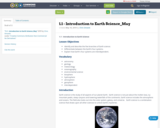
Draft of 1.1
- Subject:
- Applied Science
- Material Type:
- Activity/Lab
- Date Added:
- 05/31/2018

Draft of 1.1
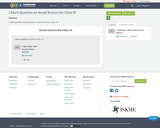
1 mark questions are prepared on social science for class 10

Activity Sheet for Araling Panlipunan 8

This course examines the causes and consequences of American foreign policy since 1898. Course readings cover both substantive and methods topics. Four substantive topics are covered:
major theories of American foreign policy;
major episodes in the history of American foreign policy and historical/interpretive controversies about them;
the evaluation of major past American foreign policies–were their results good or bad? and
current policy controversies, including means of evaluating proposed policies.
Three methods topics are covered:
basic social scientific inference–what are theories? what are good theories? how should theories be framed and tested?
historical investigative methodology, including archival research, and, most importantly,
case study methodology.
Historical episodes covered in the course are used as raw material for case studies, asking “if these episodes were the subject of case studies, how should those studies be performed, and what could be learned from them?”
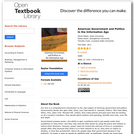
This text is a comprehensive introduction to the vital subject of American government and politics. Governments decide who gets what, when, how (See Harold D. Lasswell, Politics: Who Gets What, When, How, [New York: McGraw-Hill, 1936]); they make policies and pass laws that are binding on all a society’s members; they decide about taxation and spending, benefits and costs, even life and death.Governments possess power—the ability to gain compliance and to get people under their jurisdiction to obey them—and they may exercise their power by using the police and military to enforce their decisions. However, power need not involve the exercise of force or compulsion; people often obey because they think it is in their interest to do so, they have no reason to disobey, or they fear punishment. Above all, people obey their government because it has authority; its power is seen by people as rightfully held, as legitimate. People can grant their government legitimacy because they have been socialized to do so; because there are processes, such as elections, that enable them to choose and change their rulers; and because they believe that their governing institutions operate justly.Politics is the process by which leaders are selected and policy decisions are made and executed. It involves people and groups, both inside and outside of government, engaged in deliberation and debate, disagreement and conflict, cooperation and consensus, and power struggles.In covering American government and politics, this text introduces the intricacies of the Constitution, the complexities of federalism, the meanings of civil liberties, and the conflicts over civil rights;explains how people are socialized to politics, acquire and express opinions, and participate in political life; describes interest groups, political parties, and elections—the intermediaries that link people to government and politics; details the branches of government and how they operate; and shows how policies are made and affect people’s lives.
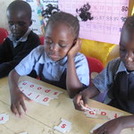
Open Textbooks for Rural Arizona participants are invited to remix this template to share their courses, textbooks, and other OER material on our Hub."Volunteers can work as support staff for the teachers at the Early Child Development Centre" by Moving Mountains Trust is licensed under CC BY 2.0.
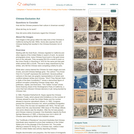
Starting with the Gold Rush, Chinese migrated to California and other regions of the United States in search of work. As several photographs show, many Chinese found work in the gold mines and on the railroads. They accepted $32.50 a month to work on the Union Pacific in Wyoming in 1870 for the same job that paid white workers $52 a month. This led to deep resentment by the whites, who felt the Chinese were competing unfairly for jobs. White labor unions blamed the Chinese for lower wages and lack of jobs, and anti-Chinese feelings grew. The cartoon "You Know How It Is Yourself" expresses this sentiment. Several political cartoons in this topic are graphic representations of racism and conflicts between whites and Chinese. "Won't They Remain Here in Spite of the New Constitution?" shows a demonized figure of political corruption protecting Chinese cheap labor, dirty politicians, capital, and financiers. "The Tables Turned" shows Denis Kearney (head of the Workingman's Party of California, a union that had criticized Chinese laborers) in jail, being taunted by Chinese men. In 1880, President Rutherford B. Hayes signed the Chinese Exclusion Treaty, which placed strict limitations on the number of Chinese allowed to enter the United States and the number allowed to become naturalized citizens. In 1882, Congress passed the Chinese Exclusion Act, which prohibited immigration from China (The Act was not repealed until 1943). The two-part cartoon from the July-December 1882 issue of The Wasp reflects how some citizens saw the situation. After the Act was passed, anti-Chinese violence increased. One illustration depicts the Rock Springs Massacre of 1885, a Wyoming race riot in which 28 Chinese were killed by British and Swedish miners. The "Certificate of Residence" document illustrates that Chinese individuals were required to prove their residence in the United States prior to the passage of the Exclusion Act. The poster offering a reward for Wong Yuk, a Chinese man, makes it clear that the United States was actively deporting Chinese. Despite discrimination and prejudice, this first wave of immigrants established thriving communities. Photographs taken in San Francisco's Chinatown show prosperous businesses, such as the "Chinese Butcher and Grocery Shop." Wealthy merchants formed active business associations, represented by the image "Officers of the Chinese Six Companies." The Chinese celebrated their heritage by holding cultural festivals, as shown in the photograph from 1896. The photographs "Children of High Class," "Golden Gate Park," and "Chinese Passengers on Ferry" are evidence that some Chinese adopted Western-style clothing while others wore more traditional attire.
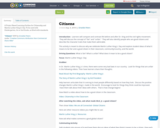
A Project Based Learning Outline for Citizenship and Martin Luther King Jr. Day. To be used with Kindergarten, 1st or 2nd Grade, as fitted with standards.

This course surveys the social science literature on civil war. Students will study the origins of civil war, discuss variables that affect the duration of civil war, and examine the termination of conflict. This course is highly interdisciplinary and covers a wide variety of cases.

This course explores how citizen science can support community actions to combat climate change. Participants will learn about framing problems, design ways to gather data, gather some of their own field data, and consider how the results can enable action. Leaks in the natural gas system—a major source of methane emissions, and a powerful contributor to climate change—will be a particular focus.
The course was organized by ClimateX and Fossil Free MIT, with support from the National Science Foundation for the methane monitoring equipment. It was offered during the Independent Activities Period (IAP), which is a special 4-week January term at MIT.

Open Textbooks for Rural Arizona participants are invited to remix this template to share their courses, textbooks, and other OER material on our Hub.
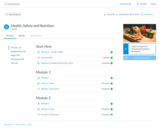
Nutrition education, menu planning, childhood diseases and illness, and sanitation and safety in group settings. Protecting the health and safety of young children and promoting the development of lifelong health habits. Communication with health professionals and parents on health, safety, and nutrition issues.
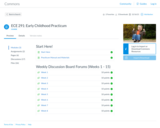
Directed field experiences with young children (birth to eight years) in varied early childhood education settings; applying child development theories and principles in support of developmentally effective approaches; planning and facilitating small and large group play-based learning experiences aligned with Arizona Early Learning Standards; refining observation and evaluation skills; adapting curriculum to children’s abilities and interests; practicing effective interactions and child guidance techniques; and evaluating the components of quality early childhood education programs. Required practicum experiences in at least two of the three early childhood groups (B-3, 3-5, or 5-8 years) and in at least two different approved early childhood settings.

Covers the study of the economic system as a whole, including the level of employment and diversity in income, fiscal and monetary policies, and the role of government in the economy. Also covers the economics of resource issues related to market failure and sustainability.

Covers the study of economic elements of supply and demand analysis. Also covers an examination of market structures, market allocation and externalities, labor markets and income distribution, and decision making by the individual firm.
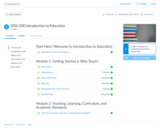
Overview of education profession and U.S. educational system; historical development and foundations of education and educational institutions. Includes theories of teaching, the student as learner, current issues and trends in education, the school and community, and roles and responsibilities of the teacher. Includes a field and observation practicum.
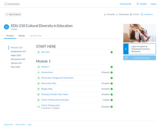
Prepares potential teachers to examine how race, ethnicity, and cultural differences influence students’ experiences in school. Assists teachers in implementing a multicultural approach to teaching by fostering critical thinking and identifying effective teaching styles and practices for a diverse student population.
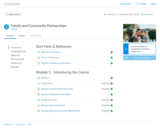
School and family relationships with a focus on communication, ethics, professionalism and problem-solving. Impact of the community, its resources and referral systems. Emphasis on families, diversity, multicultural issues and parent involvement.
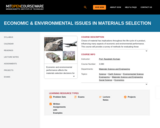
Choice of material has implications throughout the life-cycle of a product, influencing many aspects of economic and environmental performance. This course will provide a survey of methods for evaluating those implications. Lectures will cover topics in material choice concepts, fundamentals of engineering economics, manufacturing economics modeling methods, and life-cycle environmental evaluation.

This introductory course is designed to address the rapidly changing nature of computer technology and information systems in teaching and learning considering its practical and ethical impact on social, organizational, personal, and ethical issues. Students will explore new and emerging education technologies and consider their impact on the future of teaching and learning while also developing an understanding of the history of technology integration. Students will consider the digital divide and its impact on ethnicity and race pertaining to school equality and technology innovation.